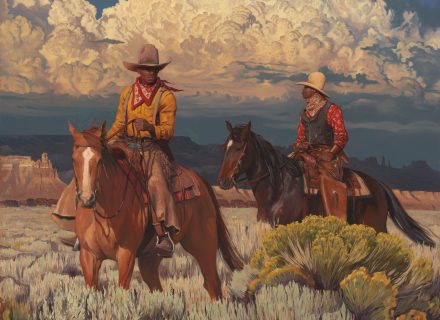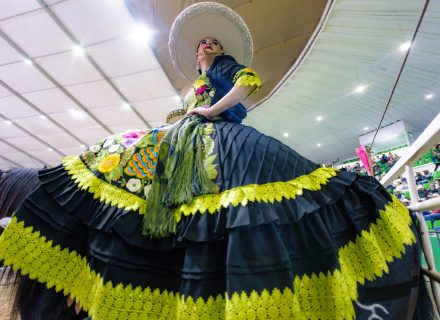Gladys Roldan-de-Moras illuminates her Mexican heritage and the vibrant history of charrería.
A young matador, dressed head to toe in traditional Spanish bullfighting attire, leans against a building as he anticipates his entrance into the arena. He gazes upward, focusing on something just beyond the stretch of the canvas, possibly something entirely invisible. Harking back to turn-of-the-century impressionism, the canvas is bathed in light. The elaborate bright-pink matador’s costume shines in the sunlight; perfectly aligned shadows stretch across the stark white adobe wall behind him. But, as dazzling as it is, the suit of light is not the story. It’s what’s in the matador’s eyes. “I wanted more of an introspection. What was he holding in his hand? What was he thinking about,” explains painter Gladys Roldan-de-Moras.
Part of the beauty of the painting — the beauty of all the exquisite work of the Mexican-American artist — lies in its crossing any cultural divide and transporting the viewer into the moment. Resplendent and celebrated as he might be, as far removed as the viewer might be from that bull ring, it is a shared humanity we experience first and foremost. Untitled (Traje de Luces), which translates to “suit of light,” won Roldan-de-Moras the Sam Houston Award for Painting at the Briscoe Western Art Museum’s 2021 Night of Artists, making it the first time in the San Antonio museum’s history that the award was decided by a unanimous vote.
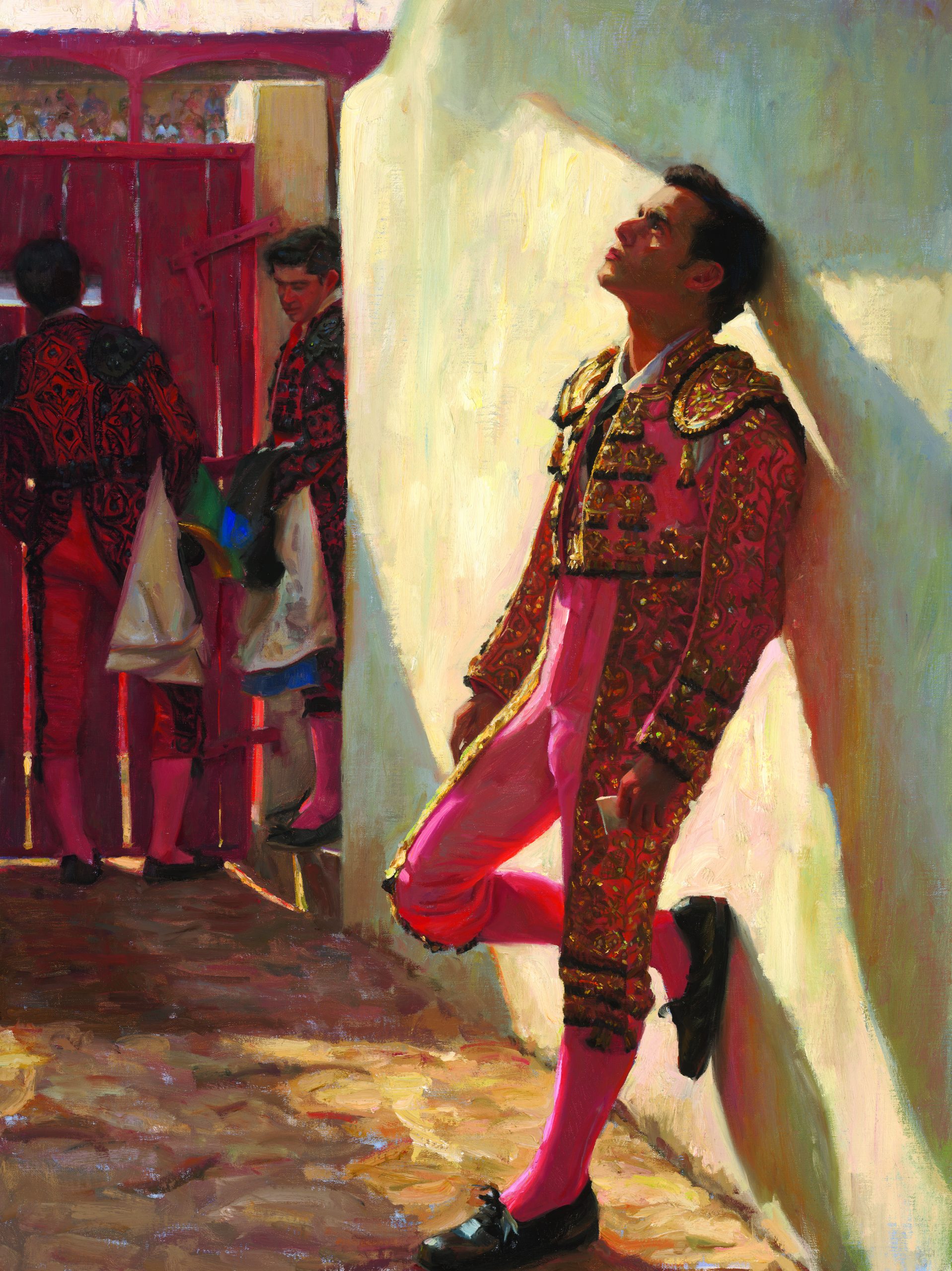 Untitled (Traje de Luces), 2022. 30 x 40 inches, oil on linen.
Untitled (Traje de Luces), 2022. 30 x 40 inches, oil on linen.
The walls of Roldan-de-Moras’ San Antonio studio are decorated with award-winning paintings — proof not just of her technique but also of her ability to draw connections between cultures with the stroke of a brush. Her striking pieces also brim with historical accuracy: She depicts charrería, the national sport of Mexico, along with other classical Mexican and Spanish traditions, with precision. She researches each painting extensively to ensure accuracy. “My heritage is what I look to represent,” she says. “I am honored to be an American citizen. This is my country now. But you always have this love for where you came from.”
After moving from Monterrey, Mexico, to Austin, Texas, in 1984, Roldan-de-Moras strove to include Western heritage into her pieces, uniting her two homes through her work. In her native Mexico, Roldan-de-Moras had fallen in love with the charrería at her maternal grandparents’ house, where she was inspired by its traditional architecture and a treasure trove of charrería outfits in her grandmother’s closet. Speaking to relatives there, she had also become enthralled with stories about her grandfather, a businessman and ranch owner with a deep passion for traditional Mexican equestrian sports. “I didn’t realize how important he was,” she says. “Talking to my uncles and aunts in Mexico, I started to understand that my grandfather had been very important in helping charrería to be declared the national sport of Mexico.”
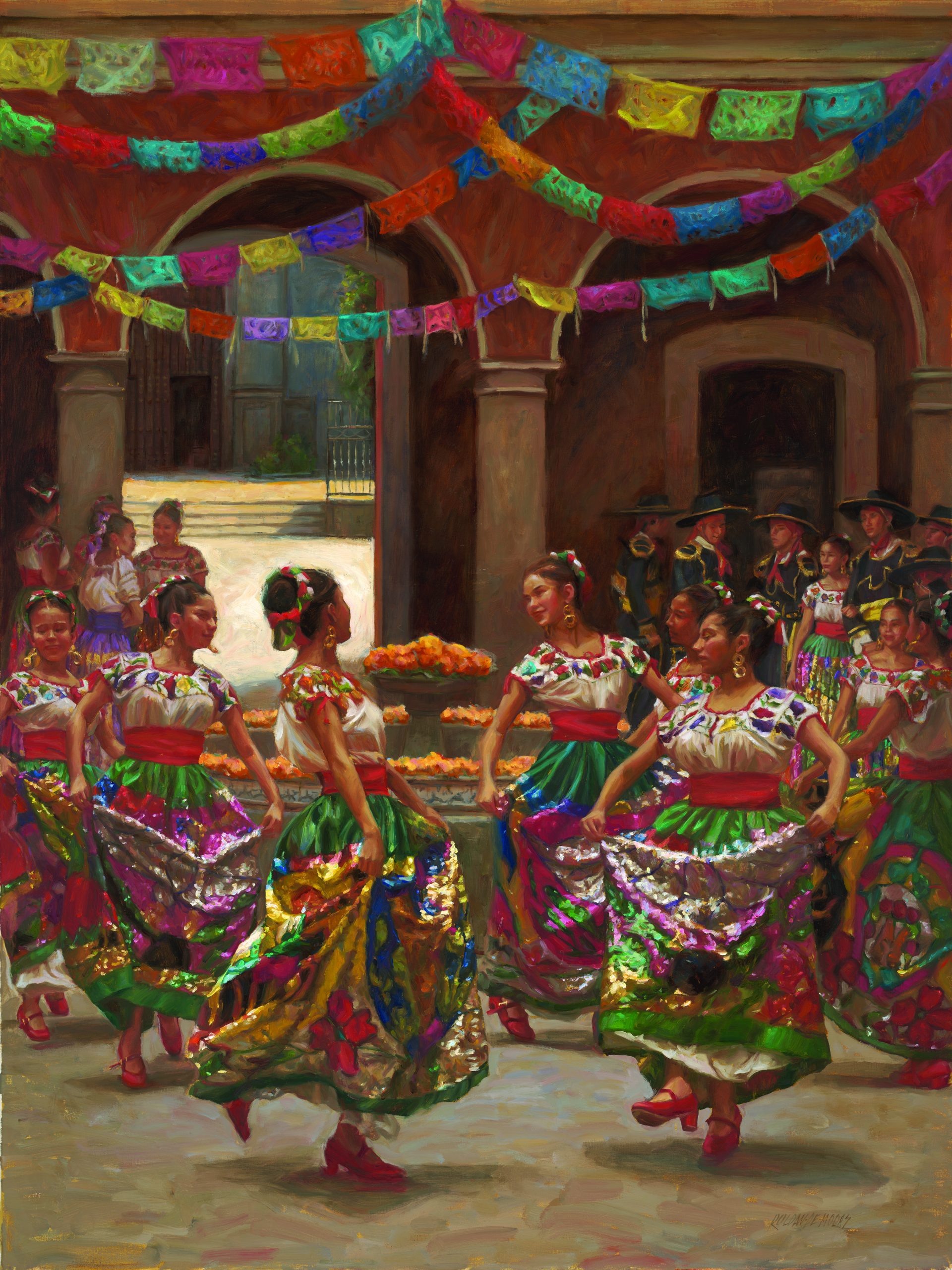 Chinas Poblanas, 2023. 48 x 36 inches, oil on linen.
Chinas Poblanas, 2023. 48 x 36 inches, oil on linen.
As her familial connection to the charrería came to the fore, so did her desire to translate it into art. But her route to getting culture to canvas would prove circuitous. “I always loved art, but my father was a very traditional, conservative man,” Roldan-de-Moras says. Although she expressed a passion for art at a young age, her father deemed painting an inadequate career option, pushing her instead to pursue medicine. She began studying medicine at Monterrey Tech in Mexico and chose to specialize in plastic surgery, eventually graduating with another degree from the University of Texas at Austin. However, after her oldest son was born with health complications, she decided it was time to get out. “I got to see medicine from the other side, the caretaker side, and I hated it,” she says. “My husband said to me, ‘Why don’t you just do what you’ve always wanted to do? I will support you and I will stand by you.’” With renewed passion, and now with family support, Roldan-de-Moras left medicine for a career in fine art.
Now, she paints every day. From around 7 a.m. to the late evening, she studies, sketches, and paints in her San Antonio studio. She pulls inspiration from music, letting the dreamlike melodies of traditional Mexican folk songs and classical music pull memories and color from her mind. “Music inspires my work a lot,” she says. “What really gets my thoughts going is live music. It gets me excited, and I start thinking, How can I represent this?”
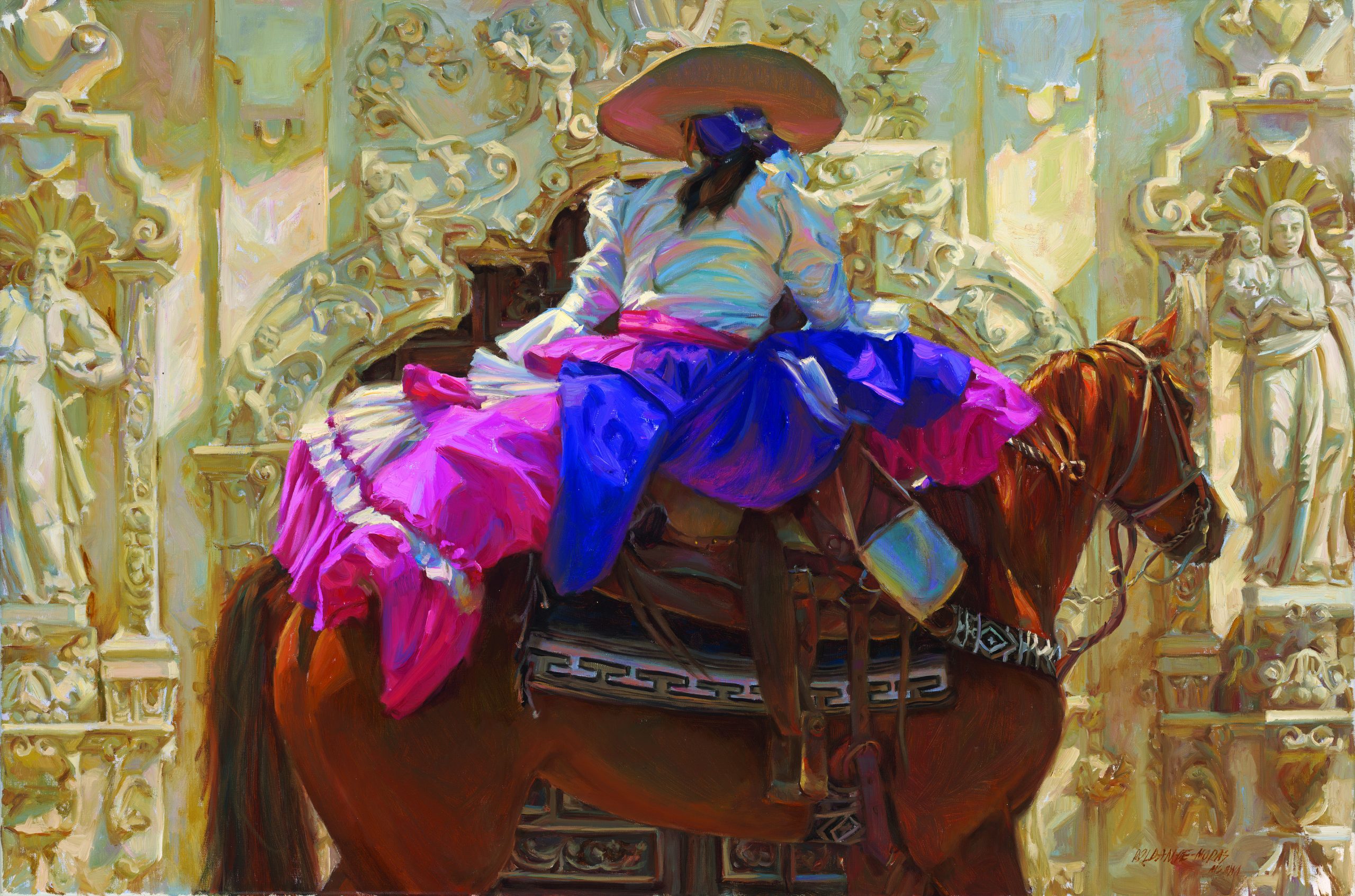 Spirit of San Antonio, 2023. 24 x 34 inches, oil on Belgian linen.
Spirit of San Antonio, 2023. 24 x 34 inches, oil on Belgian linen.
Indeed, Spirit of San Antonio, like so many of Roldan-de-Moras’ works, is a visual symphony. An escaramuza pauses on horseback in front of the doorway of San Antonio’s Mission San José. The painting is unique in its positioning of the escaramuza in the foreground of the painting. “[Women] are a very important part of the charrería tradition, but they were always in the background,” the artist says. Her goal was to give the escaramuza her own story and rightful place, on the canvas and in the larger narrative of the tradition.
When she is not in her studio creating modern masterpieces, Roldan-de-Moras teaches classes in oil painting. “I believe that that when one teaches, two learn,” she says. Besides technique, she passes along to her students her secrets to success — to keep learning and striving for self-improvement and to resist the inclination to compare oneself to other artists. “I always tell people that I worked really hard,” she says. “I continue to work very hard, to study, to learn more, but always competing only against myself.”
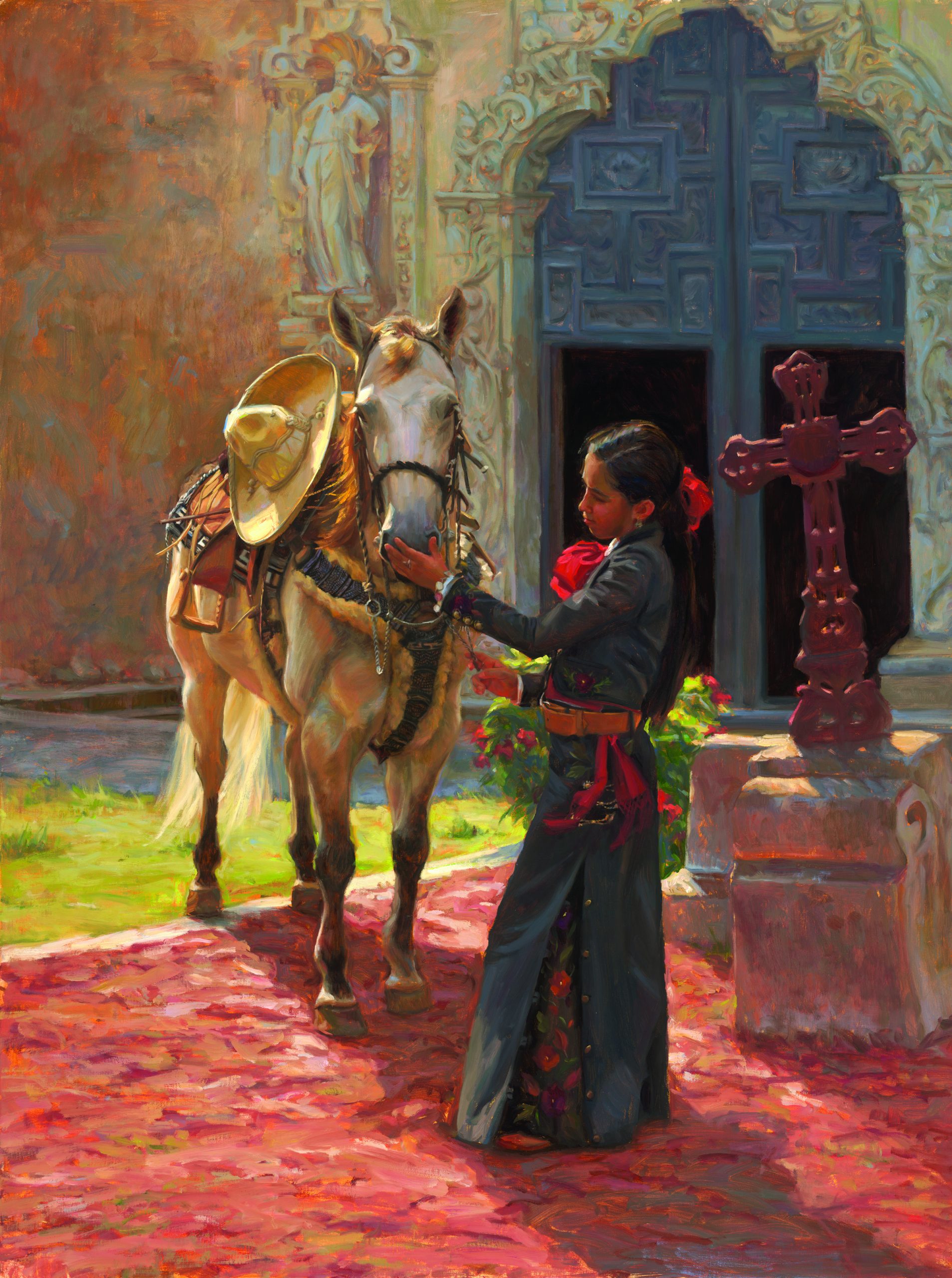 Siempre, 2023. 48 x 36 inches, oil on linen.
Siempre, 2023. 48 x 36 inches, oil on linen.
Roldan-de-Moras has also passed her artistic prowess and resilience to her three children, each of whom is involved in the arts. She takes pride in setting an example of persistence in pursuit of a dream. “They saw me from the start when I could barely buy my paints,” she remembers. “They saw me work on a dream and not give up no matter what happened. There’s nothing that should hold you back from trying. You cannot stop trying. I hope that they have learned from me.”
Roldan-de-Moras’ persistent push for greatness has established her as a trailblazer for women artists in the West and for Mexican artists across the country. In 2023, she became the first Mexican woman to be inducted into the National Cowgirl Hall of Fame. This year will mark her second Prix de West competition at the National Cowboy & Western Heritage Museum (the first year she participated, she was given the Frederic Remington Award). Next spring, she’ll be returning to the Briscoe Western Art Museum’s Night of Artists, marking several years of friendship with the museum. “I have seen this show get more and more important through the years, and I just feel very blessed to be a part of it,” she says.
For all of her many successes, Roldan-de-Moras remains humble and grateful: “It is just an honor to be here and to be representing my Mexican culture.”
Gladys Roldan-de-Moras is represented by Insight Gallery in Fredericksburg, Texas; Settlers West Galleries in Tucson, Arizona; and McLarry Fine Art in Santa Fe. Visit the artist online at roldandemoras.com.
From our October 2024 issue.
PHOTOGRAPHY: Courtesy of the artist/private collections















